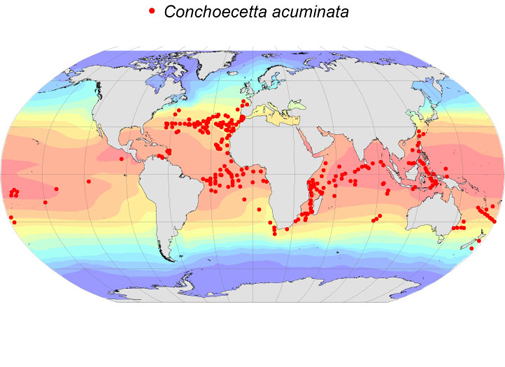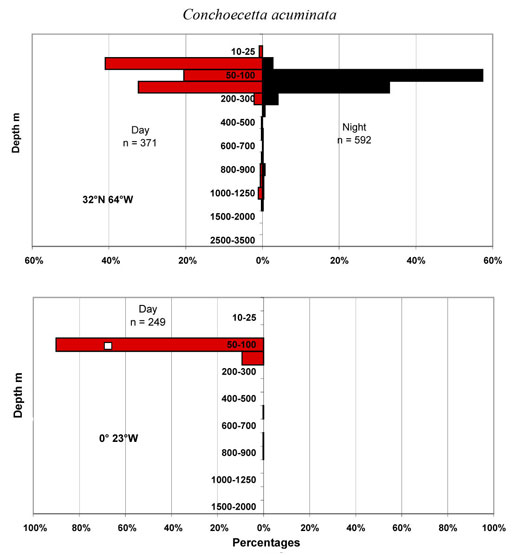Notes
405 records
This is a frequently reported species that occurs in all oceans, but it is
seldom taken in abundance. The majority of records are from latitudes
<40°; the few records that are from higher latitudes are from regions
where main ocean currents are flowing polewards (e.g. in the North Atlantic
Drift). There is an interesting gap in the North Atlantic records associated
with the region of the Sargasso Sea oligotrophic gyre, where is replaced by its
congener C. giesbrechti; so its range may prove to be limited by very
low productivity. It is a highly characteristic species with extended rostra,
an acutely angled posterior dorsal corner to the carapace, a broadly spread
right asymmetrical gland, and is very slim in ventral aspect. Such an instantly
recognizable species is seldom examined in detail during routine analyses of
samples, and so we suspect that there may be unrecognized cryptic species.
Poulsen’s size data (p.62) show tantalizing inter-ocean differences in carapace
length. Despite Poulsen’s assertion that this species regularly occurs at
depths >500m, most data associated with precise bathymetry (see the
bathymetric profiles) show that the species is a predominantly shallow
mesopelagic (c.f. Deevey 1968). The Dana samples that Poulsen (1973) analyzed
were collected using nets whose fishing depths were estimated from the metres
of wire paid out; this method can be wildly inaccurate, especially in regions
where there are fast near surface currents (e.g. along equatorial latitudes and
in regions of eastern boundary currents). It is also one of the few species
whose early juvenile instars can be reliably determined since they have lateral
extensions to the rostra that can be seen in ventral aspect. The shape of these
extensions is quite distinct from those of the co-generic species giesbrechti.Living
specimens are translucent and only very palely tinted with yellow and orange
pigments below the rostral incisure and the bases of the limbs.
| Bermuda
|
n
|
Mean mm
|
s.d.
|
Range mm
|
|---|
| Female
|
56
|
3.39
|
0.087
|
2.88-3.60
|
|---|
| Male
|
40
|
2.41
|
0.078
|
2.24-2.52
|
|---|
| A-1
|
35
|
2.23
|
0.050
|
1.94-2.36
|
|---|
| A-2
|
38
|
1.29
|
0.043
|
1.20-1.36
|
|---|
| A-3
|
31
|
0.77
|
0.043
|
0.64-0.86
|
|---|
| Equator
|
n
|
Mean
|
s.d.
|
Range mm
|
|---|
| Female
|
34
|
3.04
|
0.100
|
2.80-3.32
|
|---|
| Male
|
67
|
2.17
|
0.067
|
2.00-2.32
|
|---|
| A-1
|
66
|
1.91
|
0.098
|
1.70-2.08
|
|---|
| A-2
|
55
|
1.15
|
0.038
|
1.06-1.24
|
|---|
| A-3
|
46
|
0.71
|
0.026
|
0.64-0.76
|
|---|
| NEA
|
n
|
Mean mm
|
s.d.
|
Range mm
|
|---|
| Female
|
34
|
3.28
|
0.144
|
3.00-3.56
|
|---|
| Male
|
17
|
2.31
|
0.072
|
2.16-2.52
|
|---|
| A-1
|
53
|
2.04
|
0.083
|
1.90-2.22
|
|---|
| A-2
|
42
|
1.21
|
0.050
|
1.10-1.32
|
|---|
| A-3
|
15
|
0.73
|
0.027
|
0.70-0.80
|
|---|





